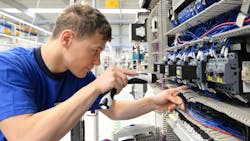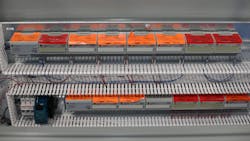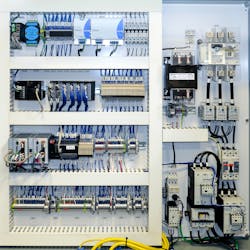Not everyone loves a parade. We all march to the beat of a different drum. Some are slow, deliberate soldiers, while others move in double-time with the grace of a dancer. But eventually we all march en masse to the prescribed destination.
Automation components have traditionally been placed within the protection of an electrical cabinet. Wiring these industrial control panels is a complex process that requires careful planning and execution, well worth the advantage of the safety and security that the enclosure offers.
However, thermal management of the cabinet and reduced machine-footprint requirements have marshalled a parade of components coming out of the enclosure and onto the machine, thanks largely to ingress protection and the swift advantages of positioning processing power where it’s needed.
March on machine
“Power supplies and motor drives help us keep high-heat components out of the cabinet and reduce the cost in cooling the cabinet, as well as the size reduction of the cabinet,” says Kevin Davidson, operators manager at Methods Machine Tools’ Detroit Technical Center.
Two major benefits sought by original equipment manufacturers (OEMs) and end users are smaller-footprint machines and reducing the cost associated with cabinet building, agrees Sandro Quintero, business development for electric automation, Festo. “They want to have one wire back to the control cabinet via an Ethernet-based fieldbus,” he says. “This is a more effective use of a technician’s time, as compared to wiring every I/O back to the cabinet. OEMs and end users want the benefits of less wiring for greater reliability and cleaner-looking machines, easier troubleshooting, faster and more trouble-free teardown and setup, and higher performance.”
Not all components lend themselves to being mounted on the machine, however. Some are more likely than others to find themselves out of the cabinet. “OEMs mount pneumatic valve manifolds on machines to increase performance because the closer the manifold is to the actuator, the faster the response time,” explains Quintero. “On the electric side, Festo has integrated a drive, motor and actuator for machine-mounted simplified electric motion and I/O blocks to distribute I/O along with manifolds across the machine.” Many sensors are machine-mountable, as well, including pressure, flow, optoelectronic, temperature and vibration, he notes.
“Electrical components can be integrated directly on the machine to simplify the wiring, integration and maintenance and to make the system more cost-effective,” says Dan Barrera, product manager, ctrlX Automation, Bosch Rexroth, who lists the most common cabinet-free technology as:
- motor-integrated drives
- cabinet-free drives, including the corresponding power supplies
- input and output modules
- housed display panels with and without an integrated PC, although less common.
Components built specifically for machine-mounting can include sensor junction boxes, communication hubs, controllers, I/O modules and variable frequency drives (VFDs), says Bill Dehner, technical marketing engineer, AutomationDirect. “Any device that has the appropriate housing and sealed connections like M12 can be easily and reliably mounted to machines and other equipment located indoors or even outdoors,” he notes.
“Of particular interest, many Ethernet switches and field I/O devices offer M12 connections, enabling machine mounting while providing the network and wired I/O connections necessary,” says Dehner. “This helps minimize field wiring, and it simplifies installation and maintenance. For many types of equipment, locally installed components with plug and cord connections provide great advantages.”
From classical to post-modern external
Many of the devices classically housed in the control cabinet have been relocated externally, explains Perry Hudson, key account manager, Pepperl+Fuchs. “You can start with communications for the machine,” he advises. “Remote I/O blocks, terminal junction blocks, logic converters, Ethernet switches, power supplies and communication masters/gateways are all available for external mounting. Frequency converters, servo controls and smart motor controllers are also available for external mounting, as are safety control modules. Edge computers and PLCs, which have always been housed in the control cabinet, can now be mounted externally when it makes sense to do so. The move is to bring the controls closer to the work, eliminating sources of error and additional costs.”
Over the past 20 years, there has been a continual march of components out of the cabinet and onto machines, declares Tom Jensen, head of system solutions and technology evangelist at Murr Elektronik. “Sensors are built to live outside the cabinet, but the I/O blocks they connect to have made the transition because they use shorter molded cables, eliminate terminal strips and promote easier assembly,” he explains. “The same with motors and the amplifiers that drive them, which are now commonly mounted together as motor modules. The next step has happened with distributed power supplies that provide the dc power bus for motion being remotely mounted to the aforementioned motor modules and finally the controller/PLC itself.”
One unintended but inspiring consequence is, when things are removed from a cabinet, all the support components are eliminated, as well. “For example,” explains Jensen, “remove the I/O and the terminal strips, overload protection and hand wiring go, as well. Take out the drives and power supplies, and the breakers go, as well—normally integrated into the power supply. OEMs are left with a cabinet and disconnect that are protecting only the PLC, which are now able to be placed out of the cabinet, too. In the market you will find technology providers that have solutions that require no cabinet—entirely IP65, from the 480-Vac input and disconnect to motors and sensors—making machines less expensive with a smaller footprint and quicker to build.”
Anything for power distribution and collection of field I/O—sensors, field cabling, passive sensor boxes, networked sensor boxes, power supplies—can be mounted on the machine, adds Jeremy Andrews, product manager, industrial field connectivity, Phoenix Contact. The standardization and acceptance of M8 and M12 circulars allow for reliable, sealed connections in a small form factor outside of the cabinet, he explains.
“With new IEC standards for products like M12 Power and M12 Push-Pull, it becomes even easier for components to be designed in with multiple quick connection points for signal, data and power,” says Andrews. “With the trend for compact, IP-rated components to be machine-mounted, fast and easy connection methods will be a key for machine builders. Heavy-duty through-panel connectors also make it easy to wire components to one or a few easy quick connect points at the cabinet wall, allowing for easy installation.”
Can you hear me now?
Updates to the IEC 61131-9:2022 standard for digital communication interface technology for small sensors and actuators—IO-Link—coupled with advancements in industrial-communication protocols, enable opportunities for the interface between industrial controllers and field devices, explains Erik Cornelsen, an automation and process control engineer in Switzerland with experience in the construction-materials industry, food-and-beverage and logistics.
“Many well-known manufacturers are developing innovative products embedded with IO-Link technology,” says Cornelsen. “Some interesting examples are safety I/O devices that communicate with the controller over ProfiSafe or I/O devices that can be mounted very close to the machinery, respecting challenging ingress-protection (IP) requirements, such as IP67. These innovations can significantly simplify the electrical wiring of the plant.”
Signals that were previously wired to the controller I/O cards or to the distributed remote I/O cards can be replaced by network cables and shorter electrical connections, notes Cornelsen. “Additional process data and diagnostics can be transmitted with the IO-Link technology,” he says. “A practical example is when using an IO-Link magnetic-inductive flow meter. Traditionally, this flow meter would be wired to a transmitter that sends a 4-20 mA signal to the controller's analog input card. With IO-Link technology, the analog connection is replaced by a digital communication, and the controller receives not only the reading of the flow, but also the temperature of the fluid, the totalized amount of fluid that passed within a certain amount of time and device status and diagnostics.”
Over the past few years, reports published by Profibus and Profinet International (PI) have shown that the number of both IO-Link and Profinet nodes have been growing exponentially. “This is very positive for the industry, as it demonstrates that these technologies are being integrated into factories,” explains Cornelsen. “Modern digital interfaces between field devices and controllers, integrated with industrial technical standards for data communication over industrial Ethernet, have among their advantages the simplification of electrical installation with increased process data and diagnostics transmission. This is the real backbone of the Industry 4.0 revolution in the shop floor, and the tendency is to continue to grow.”
Plug-and-play performance
This trend depends on which components and applications you are talking about, says Tobey Strauch, an independent principal industrial controls engineer based in Fremont, California. “There is a current push to do plug-and-play,” she explains. “Everyone wants things faster, so if you build modular, then you can simplify the interface. This means smart devices in the field.”
Take, for example, smart cameras and smart I/O.
“Manufacturers are putting the decision control onboard the camera,” explains Strauch. “This alleviates the camera controller in the cabinet. Where is this beneficial? In robotics and gantry operations. Why? Ethernet feedback can show the camera responses. Also, if it’s on the arm, the triggers and the feedback can go back to the robot, reducing decision time. Why use a PLC as a traffic cop if you do not need to? This allows systems to be plug-and-play. The robot can do all its functionality in the robot system and just provide feedback to the main process and get triggers from the main process.”
Who is taking advantage of this? Look at Universal Robots and its group of partners, says Strauch. “Robotiq allows the purchase of a palletizer, off the shelf,” she notes. “Integration is based on minimal feedback from the line, or it can stand alone, and you gate a conveyor to know when traffic is coming into the system.”
For smart I/O, IO-Link has an exponential growth since 2013, says Strauch. “Again, this is based on the plug-and-play trend,” she emphasizes, and it’s also based on economics. “If an integrator can buy three remote I/O blocks and run three Cat. 6 EtherNet/IP cables back to the cabinet, then it alleviates rows of terminal blocks and wiring,” she explains.
But, thinking further, if a line can be built modularly and there are IO-Link masters tying groups of field I/O together and bringing it back to the control cabinet, then cabinet costs are reduced, but software costs increase, reasons Strauch. “I/O becomes more database-driven, but the information is readily available,” she explains.
Ease of use is another consideration. “What if a manufacturer wants to do a tooling change and can just wheel out the one piece of equipment and wheel in the other? Smart I/O can allow for this,” says Strauch. “Also, I’m seeing IO-Link across all PLC platforms. This is cool because it will open the door to more standardization of PLC-type controls. Is it new? No. It’s changed media. Modicon was using fiber and coaxial cable to connect remote I/O and daisy-chain nodes back to the control room in 1979.”
Keep in step
This out-of-the-cabinet trend will continue where it makes sense with ever-shrinking sensors and devices, notes Heath Stephens, PE, digitalization leader at Hargrove Controls & Automation, a certified member of the Control System Integrators Association (CSIA). “However, the individual field-mount devices will always be more expensive than their cabinet-mount equivalents,” he cautions. Also, while the devices may be ruggedized, exposure to harsh operating environments may still mean field-mount devices are prone to higher failure rates and are more difficult to service, says Stephens.
Galco is seeing some remote-mount components such as mounting controllers and I/O products move outside of the cabinet and onto the machine, notes Allison Sabia, president and CEO of Galco (Figure 1). “This reduces cabling, makes troubleshooting easier and increases worker safety as there is no need to open high-voltage cabinets,” says Sabia, who also references an uptick in integrated motor-drive combinations that can eliminate panels on simpler systems.
However, it is not quite that simple, admits Andersen. “On the end-user side, there are more server-class compute resources being deployed in cabinets and microdata centers, so the end users have more capacity reducing the immediate needs for machine-mounted compute. Also, sometimes these solutions introduce a whole host of data ownership and governance issues that may come along with a machine-mounted computer, so the tech may be a bit ahead of the market-readiness,” he explains.
Closing notes
The controllers needed to run certain equipment such as dc motors or valve manifolds have become smaller, explains Freeman Smith, founder of Nufactur. “By putting the logic directly on the device, rather than in the cabinet, the user benefits from less wiring. This has corresponded with an explosion in I/O equipment and data collection on the plant floor. It is economical to have your I/O field devices mounted closer to the equipment they are monitoring. These two factors have led to less equipment in the cabinet,” he explains.
“We are continuing to see a trend toward having machine-mounted devices reducing or eliminating electrical control panels,” counters Sam Hoff, chief executive officer, Patti Engineering, a CSIA-certified system integrator in Auburn Hills, Michigan. “This happens mainly because of speed of commissioning and reduction of labor in assembling panels.”
At Prinovis, a print service provider in Liverpool, England, which is due to stop operations this summer, there have been no changes to machinery or new machinery over the past couple of years, so Mark Lee, CHP technical manager, says he hasn’t been exposed to any changes like this.
“We’ve recently seen Ethernet switches and some pneumatic items moving outside of the control enclosures. This gives flexibility of design and in certain cases saves on homeruns to the control panels,” notes Jeff Sanders, B.S.M.E., system integration manager at George T. Hall, a certified member of CSIA.
“In our industry, customers still prefer to have devices fitted into a cabinet due to easier central management,” says Joseph Yang, director of product management at Advantech.
“The need for mounting devices directly on machinery is very industry-dependent, and our technology meets both needs on a technical basis,” explains Mark Steffens, CEO at Airline Hydraulics (Figure 3). “In addition, every customer—more than 8,000 customers yearly—is unique in their requirements, and our 40 outside sales engineers and 35 in-house engineers provide value in customizing their solutions (Figure 4).”
About the Author
Mike Bacidore
Editor in Chief
Mike Bacidore is chief editor of Control Design and has been an integral part of the Endeavor Business Media editorial team since 2007. Previously, he was editorial director at Hughes Communications and a portfolio manager of the human resources and labor law areas at Wolters Kluwer. Bacidore holds a BA from the University of Illinois and an MBA from Lake Forest Graduate School of Management. He is an award-winning columnist, earning multiple regional and national awards from the American Society of Business Publication Editors. He may be reached at [email protected]

Leaders relevant to this article:





